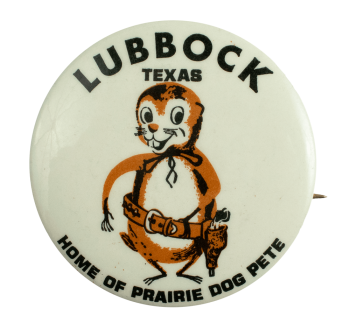| Category | |
|---|---|
| Additional Images | |
| Sub Categories | |
| Text on Button | LUBBOCK TEXAS HOME OF PRAIRIE DOG PETE |
| Image Description | Illustration of a smiling prairie dog on a white background with black text around the rim. |
| Back Style | |
| The Shape | |
| The Size | |
| Additional Information | Native to the grasslands of America, prairie dogs have long been considered pests by farmers who believe them to compete with livestock for resources. In the latter half of the 19th century and the beginning of the 20th century, government-initiated poisoning programs greatly reduced prairie dog populations. Kennedy N. Clapp and his wife, residents of Lubbock, Texas, were concerned about the survival of the species and established a prairie dog colony by trapping two pairs of black-tailed prairie dogs. In 1935, Mackenzie Park became a state park, and the colony was moved there.
The colony, known as Prairie Dog Town, quickly became a tourism draw and the city adopted the prairie dog as its mascot. Prairie Dog Pete served as the goodwill ambassador for the colony, with his image being used for promotional material. Clapp was named mayor of Prairie Dog Town in perpetuity, overseeing operations until his death in 1969. |
| Sources |
Prairie Dog Town. City of Lubbock. (n.d.). https://ci.lubbock.tx.us/departments/parks-recreation/parks/prairie-dog-town Prairie Dog Town. Visit Lubbock. (n.d.). https://visitlubbock.org/listing/prairie-dog-town/ Oliver, F., & Hamilton, A. C. (1973). Our comic friend the prairie dog and the story of Prairie Dog Town, Texas! City of Lubbock. https://ci.lubbock.tx.us/storage/images/53jgCSj7PR8BIjAkRutTlTgkJyUNC6znOWQuo5AE.pdf Opler, P. (Ed.). (1993, July). Management of prairie dog complexes for the reintroduction of the black-footed ferret. USGS Publications Warehouse. https://pubs.usgs.gov/fedgov/70039171/report.pdf O’Reilly, J. (1958, June 2). Yip, yip for Prairie Dog Town. SI.com. https://vault.si.com/vault/1958/06/02/yip-yip-for-prairie-dog-town |
| Catalog ID | AD1113 |


